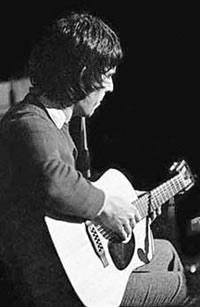

Timeline: 1971
Solo debut at The Roundhouse
On January 17 Cale performs his first ever solo show at The Roundhouse in London, playing a five songs set. He is backed by Mike Heron (of the Incredible String Band). He shares the bill with Nico, accompanying her on viola and piano.
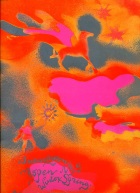
Five poems and story in Aspen Magazine
Publishes five poems and a short story in Aspen Magazine no. 9 (The Psychedelic issue). It was edited by his former bandmate Angus MacLise and his wife Hetty MacLise. It is his second contribution to the magazine: No. 3 came with a flexi-disc with his composition Loop in 1966.
Aspen was a multimedia magazine that came in a box. It was published on an irregular schedule by business woman Phyllis Johnson. Despite its name the magazine was based in New York.
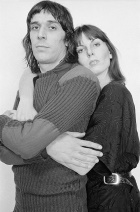
Cindy Wells
Meets Cindy Wells, member of the groupie band The GTOs (Girls Together Outrageously). The relationship will be tumultuous.
She slept with Kevin Ayers the night before the June 1, 1974 concert at The Rainbow in London. Her faux pas was immortalized by Cale in Guts:
The bugger in the short sleeves fucked my wife
Did it quick and split.
Their marriage ends in 1975. She died in 1997.

Production jobs at Columbia and Warners
After the Quadrophonic project for rival record label Columbia fails to take off, Cale joins Warners as a staff producer. He moves from New York to Los Angeles.
Warners hopes to make a quadrophonic version of A Clockwork Orange by Stanley Kubrick. The costs of refitting the theatres for the new sound is too high to make it happen.
With one eye always on the bleeding edge of technology, back in 1970, Cale was employed by CBS Records in New York to do quad mixes of their back catalogue, including records by Laura Nyro and Simon & Garfunkel. "Clive [Davis, CBS boss] had a relationship with one of the Japanese companies who offered him several million dollars to develop catalogue for quad. People got hip to all of this, this new format. It was very interesting. The problem was: how do you go from stereo to quad without screwing around with the image?
"The mixing board was very simplistic. This was when CBS Studios was run by the audio engineers' union and it was very powerful. It was like 'Don't touch the board, sonny.' But it was a question of 'How do you get pristine images?' You put the vocal on all four. One of the great tricks that we came up with was with an eight-track machine, we'd run delay from one to two, two to three, three to four. Then you bring each of these tracks up on different speakers and it'd cross the room. That was when you really got an idea of what could happen — when you had a delay that went across the room quickly, it was startling. You got this real vivid aural experience.
"We also ran into the engineering department's attempts to go over to 16-track, which was a plate that you attached and joined two eight-tracks together. It was primitive but it worked. The string section that they put on Simon And Garfunkel's 'Fakin' It' [from 1968's Bookends] was on a separate eight-track tape. The way they were sync'ed was with wax pencil marks on the tape, so you lined them up and pressed Play on both of them simultaneously and then everything would come together."
Why does he reckon quad didn't take off at the time? "I don't know. I was roped into a meeting with Warner Brothers film executives because Kubrick had just done a new movie [A Clockwork Orange] and he wanted the soundtrack in quad, which was the beginning of surround sound in film. All the heads of the departments were at this meeting and the issue was were they going to spend the millions of dollars necessary to rewire the entire chain of Warner film theatres to accommodate the new Kubrick film? I brought my quad mixes in and played some and they were seriously considering doing it. Obviously now it's got easy."
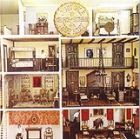
Church of Anthrax
Cale teams up with avantgarde composer Terry Riley. Result: the Church of Anthrax album, which is released in February. All tracks are instrumentals, except The Soul Of Patrick Lee, featuring a vocal by Adam Miller. Cale wanted Sterling Morrison to play guitar on the album, but he was unavailable at the time.
"Anthrax was three days in the studio with Terry Riley. John McClure was head of Columbia Masterworks at the time, and he wanted to expand the classical music line. It was not doing as well as rock and he wanted to get in on the action. We had Bobby Colomby from Blood, Sweat and Tears and Bobby Gregg from Dylan and the Hawks on drums. Adam Miller, who sang on 'Patrick Lee', was a friend of mine, a songwriter who worked mostly on commercials.
Anthrax was just an improvised gig with Terry. He got disillusioned I think, in the middle of mixing. It turned into a real mixing album. A lot of hard work went into that album but Terry felt he was being obscured. He wasn't being obscured, it was just that we'd put on so many organ tracks. To pick out a particular instrument was very difficult, so you couldn't bring him out anymore without bringing out the other instruments and making it imbalanced. He felt we were out to gang up on him, which wasn't true. As a rule he's very easy to get along with---charming, very quiet, very stable. He wants to do another album, so we're trying to set it up."
The album cover contains a short text by John Cale: Caricature.
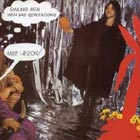
Mike Heron's Smiling Men With Bad Reputations
He performs on four tracks of Mike Heron's Smiling Men With Bad Reputations album: Audrey, Feast of Steven, Warm Heart Pastry and Beautiful Stranger. The Who's Pete Townshend and Keith Moon as well as Ronnie Lane (Small Faces) also play on Warm Heart Pastry.